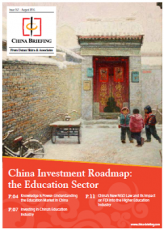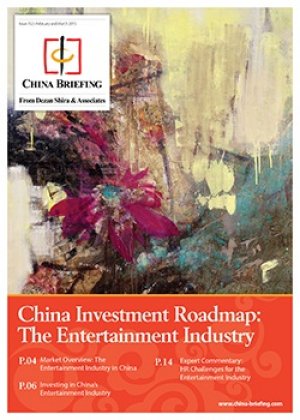Knowledge is Power: Understanding the Education Market in China
 By Dezan Shira & Associates
By Dezan Shira & Associates
Editor: Alexander Chipman Koty
China’s already immense education industry is poised to further expand in the coming years as Chinese parents prepare their children to compete in an economy far different than the one they grew up in. After decades of relentless growth facilitated by an abundance of low cost workers, China is transitioning to a more mature development model reliant on services and skilled labor – and increasingly affluent Chinese families are investing in education to meet these needs. Already worth RMB 1.6 trillion (US$240 billion) in 2015, China’s education market is projected to nearly double to RMB 3 trillion (US$450 billion) by 2020.
The growth of China’s education industry is striking. Investment cases grew from 190 in 2014 to 270 in 2015 – an increase of 42 percent – and the amount of mergers and acquisitions and IPOs rose by 165 percent and 76 percent, respectively. All told, investment catapulted from RMB 6.1 billion ($913.4 million) to RMB 15.9 billion (US$2.4 billion) year-on-year.
Although China is experiencing a long-term aging population, the size of its current youthful population remains significant. Of China’s 1.37 billion citizens, 17 percent are between the age of 0 and 14 – approximately 233 million in need of education. The parents of this nearly quarter billion contingent of children are wealthier than previous generations and prepared to pay a premium for education. In addition to China’s longstanding cultural emphasis on education, the country’s one child policy gave parents strong incentives to invest heavily in their children, as parents and grandparents are often dependent on a single child for support as they age. The relaxation of the one child policy in recent years, however, may lead to an increase in newborns at a time when many Chinese families are prosperous enough to comfortably raise more than one child.
 RELATED: Pre-Investment and Entry Strategy Advisory
RELATED: Pre-Investment and Entry Strategy Advisory
Surveys consistently show that Chinese families prioritize spending on education ahead of any other area, including real estate and retirement savings. Spending habits support this statement, as the McKinsey Global Institute projects the country to spend 12.5 percent of its overall consumption growth on education for those under 30 over the next 15 years, the most in the world aside from Sweden. Further, according to ICEF Monitor, almost half of a Chinese 20 year old’s per capita consumption is spent on education, in contrast to less than a quarter for an American. These expenditures are significant and set to rise, as the working age urban middle class is forecasted to increase to over 50 percent in 2030 compared to just four percent in 2010.
Despite the willingness of Chinese consumers to spend on education, foreign investors face several challenges entering the market. The Chinese government is often suspicious of foreign involvement in education, and holds strict control over curricula. Foreign participation is prohibited in compulsory education spanning ages 6-15, and most types of educational facilities require establishing a joint venture with a Chinese partner. The Chinese education system’s rigid fixation on standardized examinations further restrict what forms of education are in demand for students below the tertiary level. Despite these limitations, there is robust demand for foreign education services as highly competitive consumers value the quality of overseas expertise.
While certain sectors of China’s education market are highly saturated and extremely competitive, such as English language training (ELT) schools and preparatory schools for the Zhongkao, Gaokao, and SAT exams, demand for other more specialized education institutions is rising. Some of these are specifically promoted by the government and benefit from favorable policies, while others are emerging due to the growing awareness and spending power of Chinese consumers.
Vocational Education
The Chinese government recently pledged RMB 10 billion for the development of infrastructure for new vocational schools, with local governments supplying even more. There were 29.3 million Chinese studying applied skills, such as technical IT training and other trades, at vocational schools and colleges in 2014, comprising 6.3 percent of the education market. By 2020, the Chinese government aims to have 38 million students in vocational schools, but these schools are often looked down upon in China, and the majority of teachers are unqualified. As the government pursues a growth model increasingly demanding skilled labor, the development of vocational schools into trustworthy sources of applicable skills and knowledge is key. Such institutions are the only form of education explicitly listed as encouraged for investment, reflecting the need to attract services in this area.
Early Childhood Education
Early childhood education, which covers education for children below the age of three, is a promising growth sector benefiting from rising disposable income levels. Since 2009, China’s baby care industry has grown by 55 percent per year, demonstrating the willingness of Chinese families to spend heavily on young children. While the Chinese government is still focusing on increasing enrollment in preschools and kindergartens, the education market for children too young for these institutions is growing. Due to the youth of these children, such facilities must act as nurseries in addition to providing early education. However, China’s early childhood education sector suffers from a lack of regulations and oversight. About 60 percent of early childhood education schools are registered as consulting companies or educational training centers and are not connected to the local government’s education department. Some overly ambitious schools promise to teach advanced topics such as English and mathematics in early preparation for future examinations despite the fact that students are aged three or younger, and only about 10 percent of teachers in early childhood education institutions actually have teaching certificates. These issues point to the need for more formalized and higher quality education in this sector.
Special Education
Special education is another field that is largely absent in China. It is generally quite difficult for students with physical and learning disabilities to receive individualized education services tailored to the unique challenges they face. Even accessing general education services is often problematic, as only about 72 percent of children with disabilities enroll in school, compared to 99.6 percent of their able-bodied peers. Special needs students who participate in general education institutions are often discriminated against or have their needs misunderstood, and schools usually lack the resources to care for them. Indeed, many children with learning disabilities do not even have their conditions recognized to begin with. Those with speech and communication disorders, for example, suffer from a lack of resources and qualified care. In 2010 there were only about 1,000 speech-language pathologists (SLPs) in all of China, many of which were trained for under six months and sometimes only two weeks. Support for students with physical disabilities such as deafness is slightly better, though the type of education they can pursue is often limited and facilities lack accessibility. As awareness of students’ special needs grows, there will be increasing demand for specialized education that cannot be provided by mainstream institutions.
 This article is an excerpt from the August issue of China Briefing Magazine, titled “China Investment Roadmap: the Education Sector.” In this issue of China Briefing, we navigate through China’s regulatory framework for investment into education, presenting a roadmap for best practices in the industry. We examine the key market information that has driven the industry’s growth, analyze the different investment models that are available for foreign companies, and finally discuss the effect that China’s recently released NGO law will have on foreign investment into education. This article is an excerpt from the August issue of China Briefing Magazine, titled “China Investment Roadmap: the Education Sector.” In this issue of China Briefing, we navigate through China’s regulatory framework for investment into education, presenting a roadmap for best practices in the industry. We examine the key market information that has driven the industry’s growth, analyze the different investment models that are available for foreign companies, and finally discuss the effect that China’s recently released NGO law will have on foreign investment into education. |

 Establishing & Operating a Business in China 2016
Establishing & Operating a Business in China 2016
Establishing & Operating a Business in China 2016, produced in collaboration with the experts at Dezan Shira & Associates, explores the establishment procedures and related considerations of the Representative Office (RO), and two types of Limited Liability Companies: the Wholly Foreign-owned Enterprise (WFOE) and the Sino-foreign Joint Venture (JV). The guide also includes issues specific to Hong Kong and Singapore holding companies, and details how foreign investors can close a foreign-invested enterprise smoothly in China.
 China Investment Roadmap: the Commercial Real Estate Sector
China Investment Roadmap: the Commercial Real Estate Sector
In this issue of China Briefing, we explore the latest trends in commercial real estate in China, and discuss how foreign companies can benefit from China’s massive construction boom. We provide a guide to how firms can sell construction materials in China, and finally detail how foreign architects can most effectively enter and take advantage of China’s rapid urbanization.
China Investment Roadmap: The Entertainment Industry
In this special edition China Briefing Industry Report, we cast our gaze over the broad landscape of China’s entertainment industry, identifying where the greatest opportunities are to be found and why. Next, we detail some of the most important issues for foreign investors to be aware of, including legal, regulatory, and tax considerations specific to the industry. Lastly, we provide an insider analysis of the sector’s unique HR & payroll challenges.
- Previous Article Registered Capital, Company Loans, and the Timely Repatriation of Profits for WFOEs in China
- Next Article Assessing the Hong Kong – Russia Double Taxation Agreement: Another Step Towards Amplifying China’s Eurasian Connection










